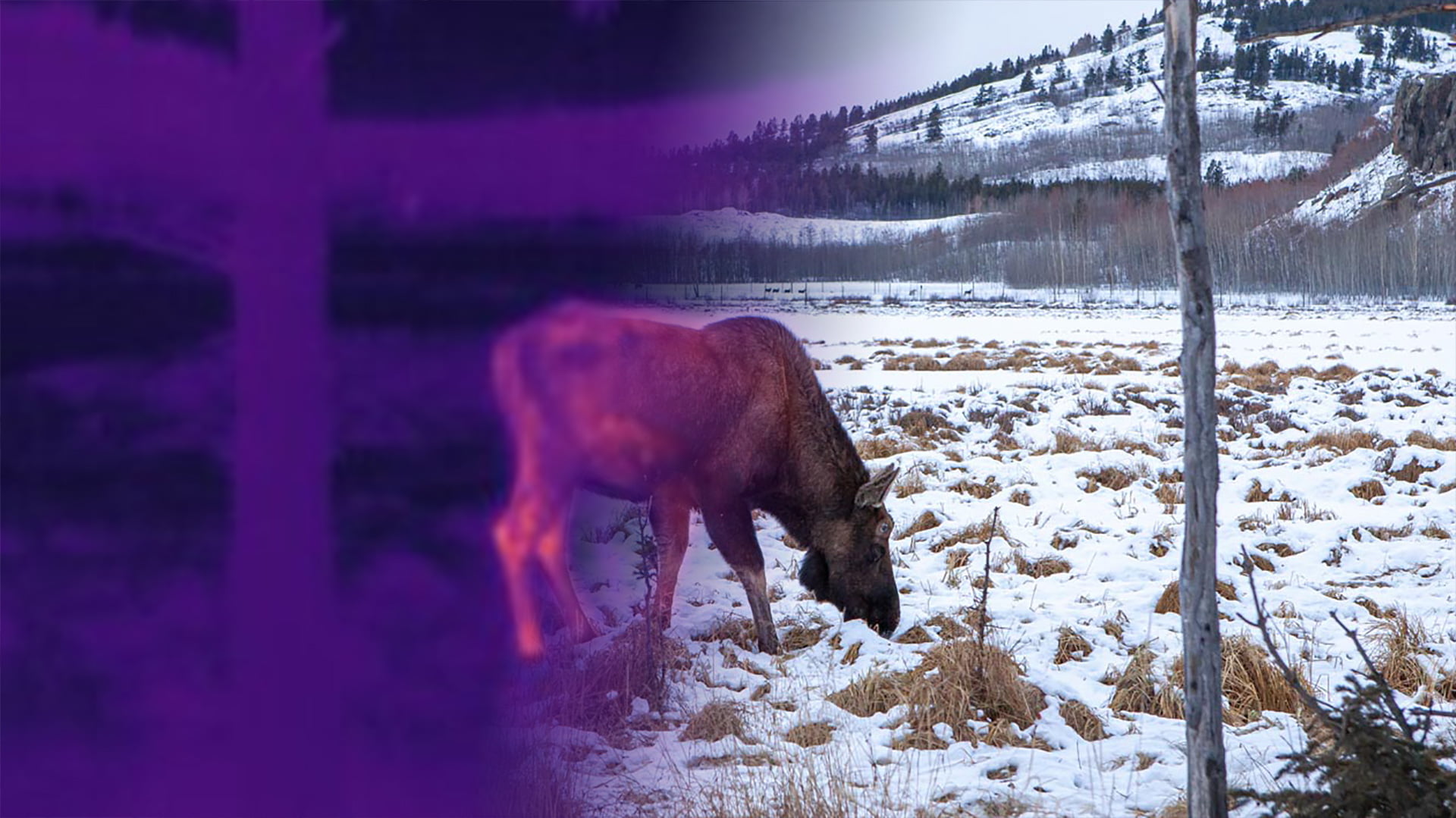
Winter Heat Losses
15 minute read –
This is Part 2 of a 4 part series by guest author and ecologist, Joshua Robertson on how wildlife at the Yukon Wildlife Presere stays warm (thermoregulates) in the winter. Read Part 1. The article was edited on March 15, 2021 to update heat loss calculations.
In my last post, we discussed the unfortunate reality that winter in the Yukon isn’t cheap. Each year, we spend our money on mittens, insulated boots, toques, and hand-warmers to protect ourselves from hypothermia or nasty frost-bite injuries. (Or we don’t, and pay with a mysterious and unpredictable loss of feeling in certain appendages. It’s not something I’d recommend).
But just how inefficient are we? And why?
For those living in Whitehorse or Dawson, heating a living space to a comfortable degree probably means spending at least $75.00 more on electricity bills each month relative to the summer or fall. Similarly, for those in rural areas, costs of warming a home are likely paid by increasing the total amount of wood burnt per day. And as we know, collecting and splitting that wood is not easy, nor is it quick.
But as the wildlife enthusiasts that we are, we also took a step back from our human experience to ask “what do costs of winter look like for other year-round and sympatric animals?” (remember, sympatric means “living in the same place”). In doing so, we stumbled upon three rather intriguing trends:
- Like us, practically all animal species that one is likely to observe in a Yukon winter (each of which are “endotherms”, meaning that they produce their own body heat) are almost certainly paying extra to keep their bodies warm. Rather than paying in dollars, however, these animals are paying with proteins and fats that were sourced from breakfasts of mice or spruce cones.
- For some species, such as the Red Fox, the costs of keeping warm in temperatures below -20°C amount to chump-change. One Masked Shrew extra a day or so. No big deal. For other species, such as the Black-capped Chickadee, such costs can be frightening astronomical (+70% of usual expenditure). Although these differences in the relative costs of warming across animals can be partly explained by variations in body size, variations in the capacity to capture and store body heat also seem to play an important role in the story.
- Despite inhabiting cold environments for thousands of years, and despite using high-tech, insulative winter gear, humans appear to spend quite a bit more energy on keeping warm throughout the winter than one might expect – particularly when compared with other large mammal species. But just how inefficient are we? And why?
Now that we’ve summarized our previous findings, let’s return to the objectives that we outlined in our last post. Jake Paleczny and I were interested in understanding just how efficient or inefficient we humans are at keeping warm when compared with a few animal species that reside in the Yukon through the winter months. We were also curious to know how the efficiency of keeping warm varied across a suite of animal species, and why such differences occur. To gather more information, we used an infrared thermographic camera and some biophysical knowledge to measure the amount of heat that animals at the Yukon Wildlife Preserve (including Jake) lose to the environment on a cold day. With these measurements, we then estimated and compared just how much energy each animal would have to spend to maintain a stable body temperature throughout a few hours of cold exposure. Now that we’re back up to speed, here’s were left off:
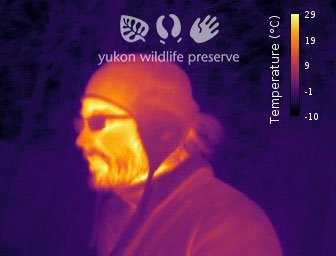
Above is an infrared thermographic image of Jake, wandering the preserve at around -12°C. Remember, in these types of images, bright colours represent warm surfaces and dark colours represent cold surfaces. From this image, we calculated that if Jake were to continue wandering the preserve for 4 hours, the amount of heat lost across his face alone would amount to one tenth of a MacDonald’s cheeseburger. To this, you said “that’s not so inefficient!” (or at least you may have in my internal dialogue). And my reply?
Well, why don’t we step back and have a look at Jake’s entire body. But before doing so, let me note that Jake is no novice when it comes to outdoor exploration in cold weather. He’s spent enough hours in sub-zero temperatures to know that wearing Converse shoes and forgoing underlayers simply isn’t worth the discomfort (as much as the teenage version of myself denied it).
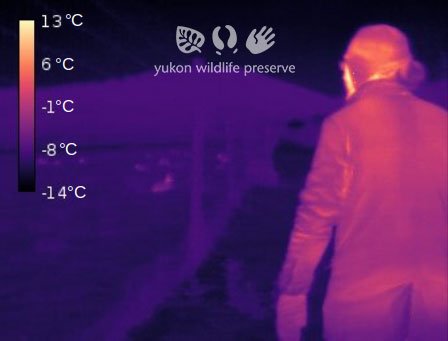
Okay, I’ll admit that I’m not the greatest field photographer. Nevertheless, the thermographic image above will suffice to make a reasonable estimate of heat-loss across Jake’s entire body on this chilly day. An important observation from this image is that parts of Jake’s body are slightly warmer and poorer insulated than others; his head, hands, and upper back seem to be particularly susceptible to heat-loss. This tells us that if we want to paint a reliable picture of Jake’s whole-body heat-loss, we must first estimate the rates of heat-loss across major body parts (the torso, pelvis, legs, arms, head, and hands), then sum these values. Below, this is precisely what I’ve done. I’ve also expanded our whole-body estimate across 4 hours of outdoor walking to be consistent with when we estimated heat-loss across Jake’s face alone. So how many cheeseburgers worth of energy is Jake using to keep warm at -12°C?
Two and one tenths cheeseburgers! That’s quite a lot of cheeseburgers!
If you’re a lover of winter like myself, you’re likely thinking “wait a minute. I spend plenty of time outside in cold weather and I can’t possibly be losing that much energy when I do. How does this make sense?” This is an insightful concern to raise. So, on reflection, is our estimate missing an important piece of information? The answer is, yes, it is; and that is, just how much heat do we generate and lose, on average, barring exposure to the cold? What we are really interested in is not how much energy Jake is losing as a consequence of heat-loss, but rather, how much more (emphasise more) energy Jake is losing relative to his normal day-to-day life by being out in the cold. Jake is already spending a certain number of cheeseburgers on heat production by virtue of being a “warm-blooded” animal (or “endotherm”). But how many more cheeseburgers is he using for heat production at -12°C? We can call this unknown value his costs of “cold-induced thermogenesis”, a fancy way of saying “his costs of making new heat (called thermogenesis) to make up for what is lost to the cold air”. To clarify what I mean, take a look at the diagram below.
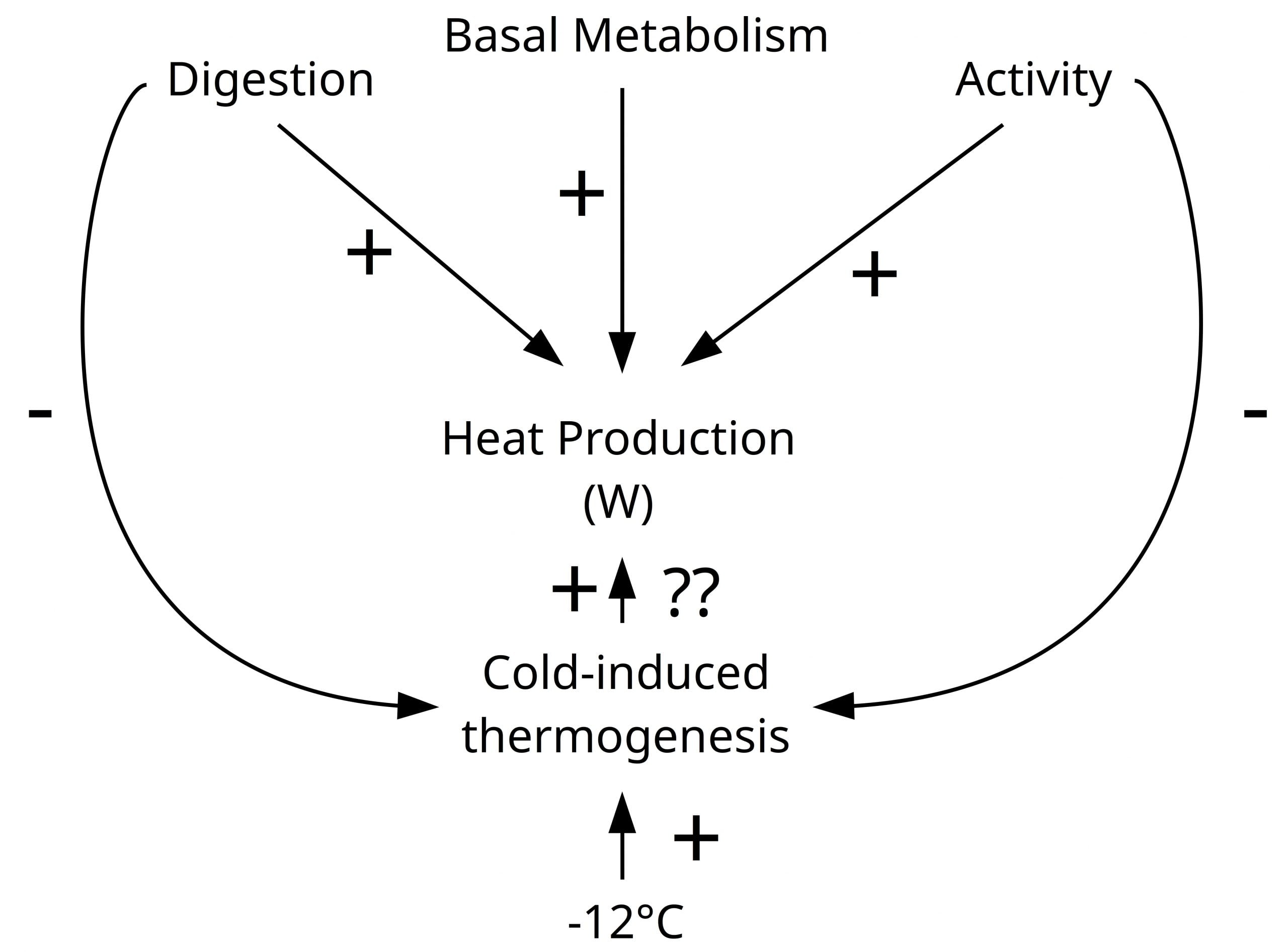
As I mentioned above, Jake is always going to be spending some amount of energy on heat production, regardless of the weather. Such heat production is an intrinsic property of life as an endotherm and we can define to its absolute minimum value as “basal heat production”. (In reality, I’m over-simplifying here. Even “cold-blooded animals”, or ecotherms, produce some heat just from existing, but basal heat production in these animals is small enough to ignore). In the diagram above, basal heat production is indicated by the arrow leaving “basal metabolism” (meaning, “minimum bodily function”) and pointing to “heat production”. So, this means that if we’re truly interested in how much more energy Jake is losing from cold-exposure relative to normal circumstances (again, his costs of “cold-induced thermogenesis”), we should take his measured heat loss and subtract his basal heat production. But doing so only gets us part of the way there. Why? Because we’re also missing a few other important and regular contributors to heat production that we’ll need to subtract. These contributors are digestion and physical activity, each of which are also indicated with arrows in the above diagram and were briefly touched on in our previous discussion.
Conveniently, in Jake’s case, already know his activity level; he was walking at a leisurely pace. Estimating Jake’s digestion level, however, is slightly trickier. For the sake of simplicity, we’ll just assume that he skipped his lunch. And lastly, what about his basal heat production? Thankfully, plenty of research has been done on basal heat production in humans, so we don’t need to make an estimate from base principles. For this post, I’ve used Ken Parson’s book called “Human Thermal Environments” as a resource. With all of this information in place, we’re set to estimate Jake’s true costs of cold-induced thermogenesis. And the result is…
Approximately one whole cheeseburger! That’s right, despite donning full winter gear, Jake would still use a full cheeseburger worth of energy to keep warm on his four hour walk. Recall, that’s one more cheeseburger worth of energy than he’d normally use in day-to-day life. Now
- If you’re spending long periods of time outdoors in the winter, you have very good reason to eat second helpings; and,
- For ease, these estimates are made assuming no wind. Factor in a modest wind and we’re looking at around pi (3.14…) cheeseburgers.
I know, I know, I’m being long-winded. Enough about Jake and pi. What about the other animals at the Yukon Wildlife Preserve? How do they match up? Well, remember the Thinhorn Sheep (or Dall Sheep)? If not, have a look at the thermographic images below.
With a quick look at the images, we can already see that the amount of heat escaping from most of the sheep’s body is less than that escaping from Jake’s. But does this truly mean that the sheep is spending less energy on warming in the cold than Jake is? Well, using the same approach we used to estimate Jake’s cost of heat loss (see above), the answer is…
No! Well, more accurately, a tepid not quite. According to estimates of basal heat production in a close relative, the Bighorn Sheep, this Thinhorn Sheep is probably using about one and three quarter cheeseburgers worth of energy to maintain a stable body temperature in -12°C (and again, across 4 hours). That’s quite close to Jake’s value of one cheeseburger. But, given that this handsome fellow is wearing nothing but his fur, and given that he’s probably slightly heavier than Jake, you have to admit, that’s impressive. I should also mention that my estimates of heat loss for the Thinhorn Sheep are coarse and likely higher than true values, thanks to the limited amount of data available on body size in this species. My guess is that the true number of cheeseburgers used to counteract the cold exposure is sitting slightly below one.
Okay, so the Thinhorn Sheep can contend with Jake in winter gear, but can’t totally outstrip him. What about a different species that is commonly viewed in the Yukon? Perhaps one with a slightly larger body size? A good candidate here might by the North American Moose (depicted in the thermographic images below).
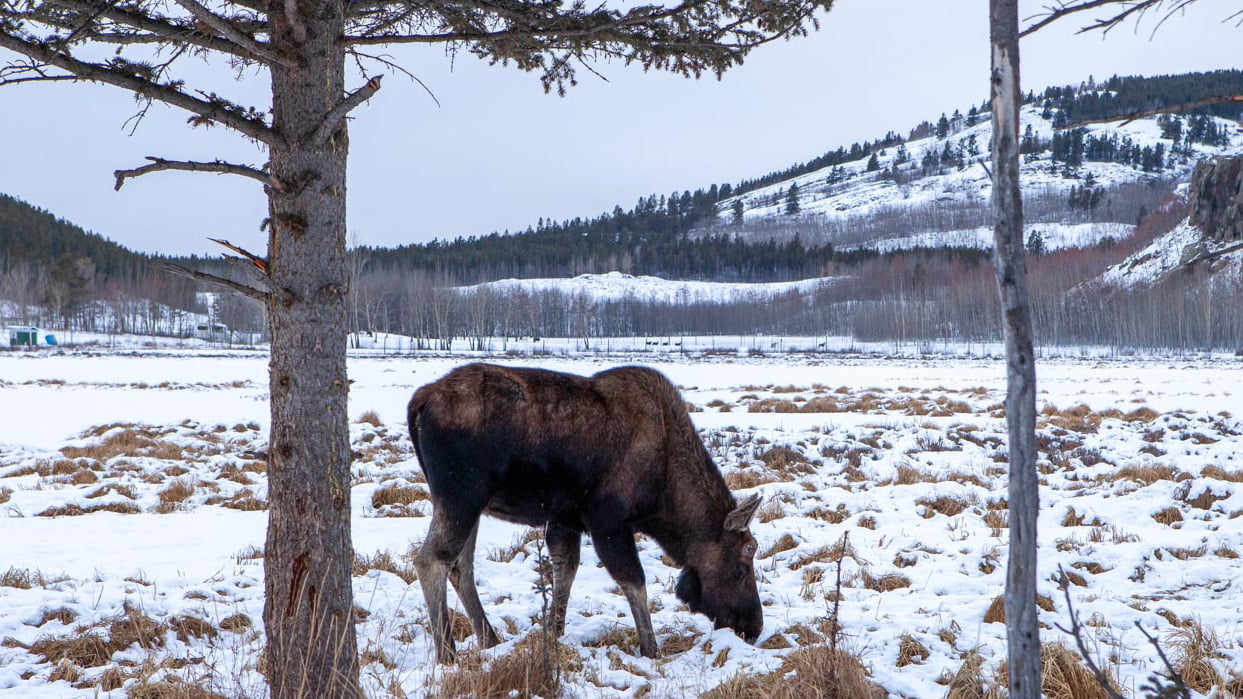
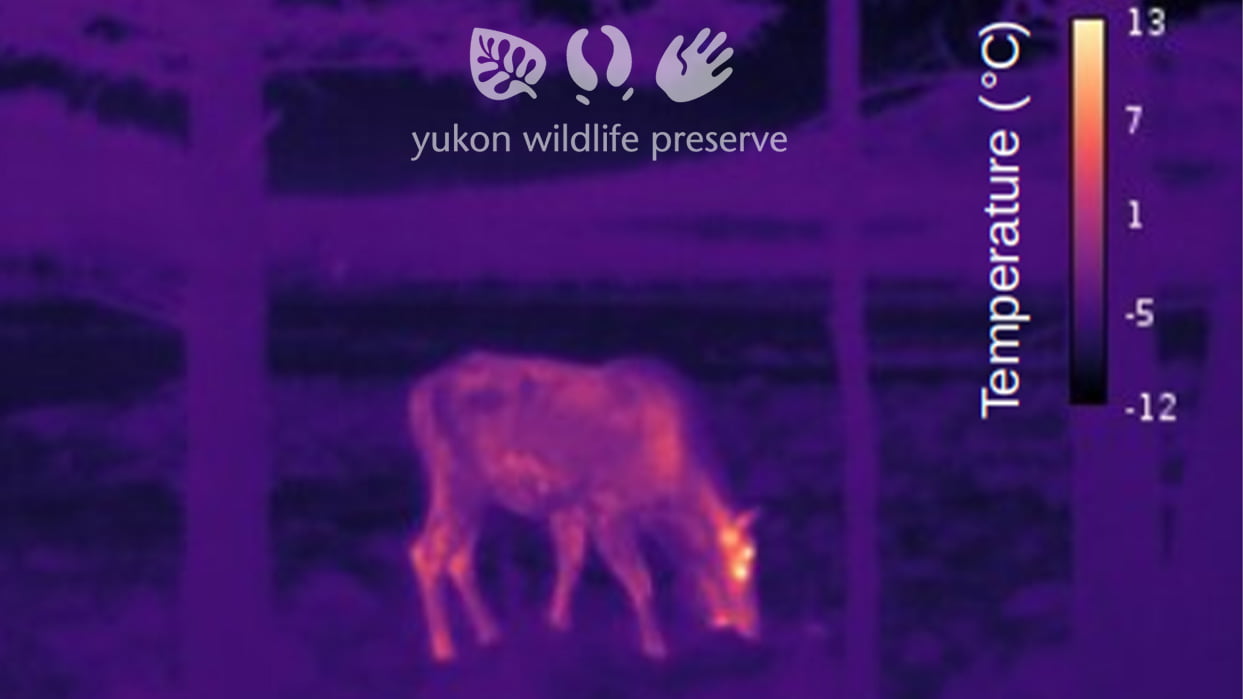
These images are curious. For those who have had the fortunate opportunity to view Moose at close proximity, the rapid rate at which heat is escaping from the legs and body of this individual may not be too surprising. Indeed, the thickness or “depth” of the fur in this species is not large, meaning that it probably doesn’t serve as a magnificent insulator. The curious side of this information, though, comes from the knowledge that Moose have survived winters in northern North America for thousands of years. For that reason, one might expect their natural insulation to be slightly more effective, correct? This conundrum is one that I’ll dissect in a later discussion, but for now, let’s get to the important question. How costly is our perceived heat loss for the Moose in question?
If you guessed “very”, your both correct and incorrect. On our -12°C day, this Moose is likely losing about 10 cheeseburgers worth of energy to heat across a 4 hour period. That’s quite a lot of cheeseburgers. However, the average rate at which Moose produce heat is remarkably high, owing to a fairly fast metabolic rate. If we factor in this rapid metabolic rate (as we have for Jake and the Thinhorn Sheep) our Moose is actually spending less on warming, relative to it’s usual energy consumption, than Jake is – only three-quarters of a cheeseburger Impressive huh?
So it seems that Jake is having a tough time standing up to the Yukon competition. But just for fun (and a hint of cruelty), why don’t we test him against a true specialist; a species that is unique adapted to harsh and extreme winter conditions.
Now there is a good contender. Above, we have two thermographic images of the same female Muskox. Take a close look at the back and flanks of our Muskox in the right-hand thermographic image. It’s difficult to tell by eye, but by using a computer, I can tell you that the average temperature on the surface of this body region is around -7.8°C. For reference, the core body temperature of a Muskox hovers around 38°C (you can see this in a study by Schmidt and others that was published last year in the journal Scientific Reports). This means that barely any of the heat produced by the body of this muskox is escaping to the external environment. As for Jake, the average temperature on the surface of his back was around -0.4°C – a whopping 7.4°C higher. Thought the insulation on the Thinhorn Sheep was impressive?
“But what about total heat loss in the Muskox?” you ask? Before I reveal the answer, I’ll note that early research in this species has shown that basal energy expenditure in adult females approximately triples that of an average adult human. Not as high as the Moose, but notably high nonetheless. Remember, from the diagram above, this means that metabolic heat production during day-to-day life will be raised in our Muskox relative to Jake. Nevertheless, the total cost of heat loss in the imaged individual is a surprising..
– One half of a cheeseburger! Yes, that’s negative one half of a cheeseburger. And this value isn’t even proportional to usual energy consumption in the Muskox. This means that at -12°C , our Muskox doesn’t appear to be spending energy on extra heat production at all. Rather, she’s actually accumulating heat. Despite knowing that this species is strongly adapted to cold climates, I have to admit, this estimate still surprised me. Insulation capacity of the Muskox is truly astounding and can partly be attributed to their interestingly soft and woolly underlayer called “qiviut”. As you can imagine, maintaining this level of insulation in the hot days of the summer could contribute to extreme heat stress. To avoid this issue, Muskox shed their qiviut each summer, thus allowing them to more easily dissipate their excess, and potentially toxic, body heat.
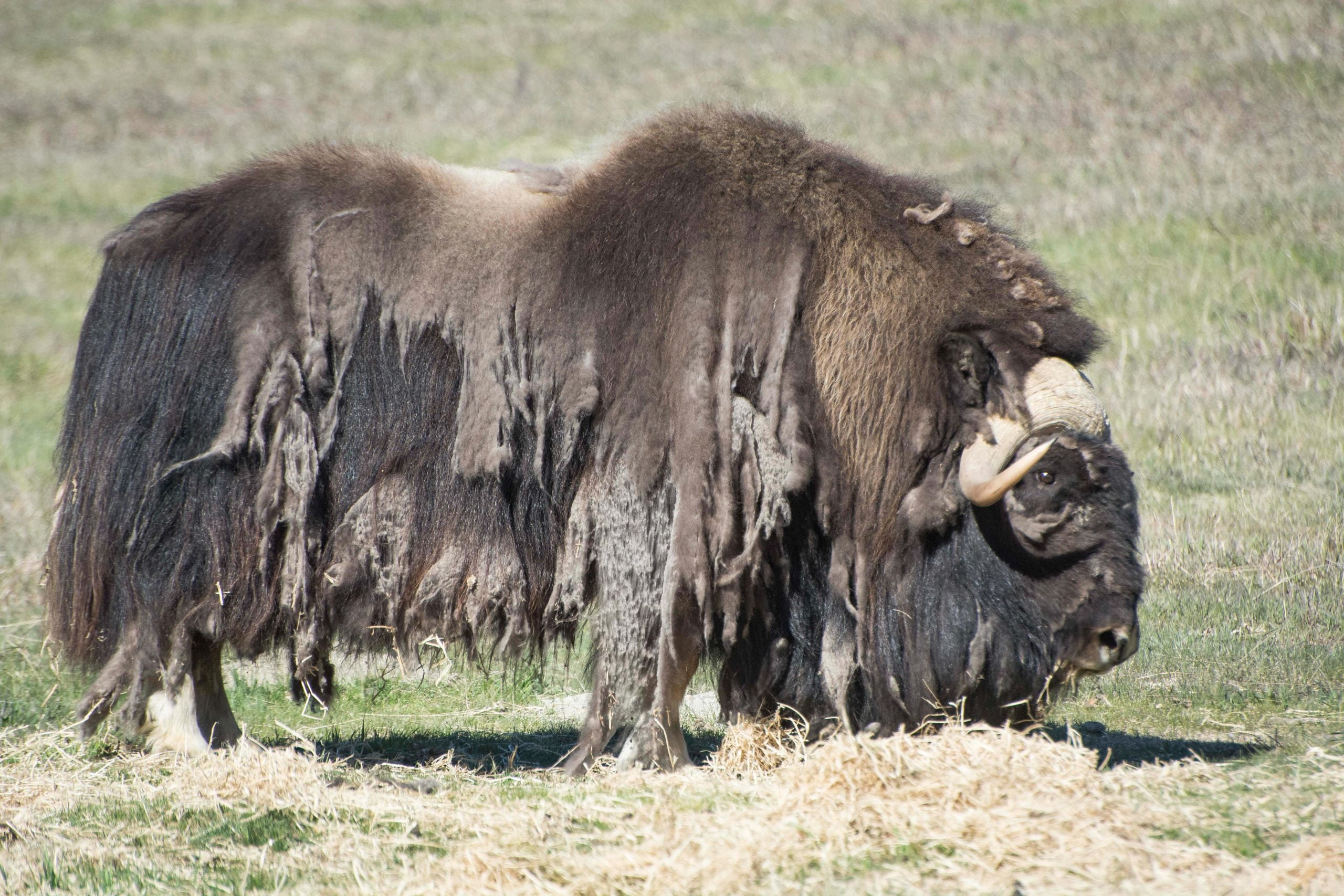
You might be thinking that all of this information is certainly interesting, but a bit restricted. After all, just how extreme is -12°C anyway? And what if Jake weren’t wearing any insulative clothing? How would he compare to other Yukon endotherms then? These are all great questions. In the next post, I’ll use thermographic images captured during a cold snap in January to answer each of them to the best of my abilities. After that, we’ll see if we can start drawing some meaningful inferences from how the heat-storage efficiency of these animals compare with one another. For now, I’ll leave you with the below, rather startling image.
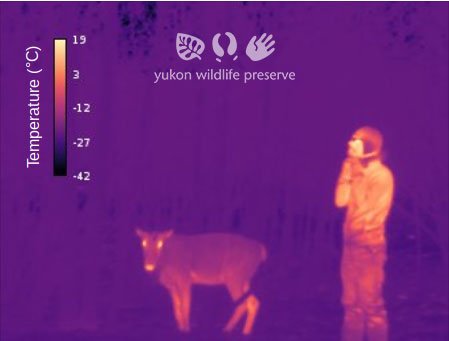
To re-assure you – yes, you’re reading the scale bar correctly.

Joshua Robertson
Behavioural and Physiological Ecologist
Joshua is a behavioural and physiological ecologist currently living on Cape Breton Island, Nova Scotia. During his PhD at Trent University, Joshua sought to understand how small birds can cope with the high costs of body temperature regulation when challenged with other environmental stressors (such as human and predator exposure). He is currently extending the research to better understand energy management strategies in warm-blood animals.

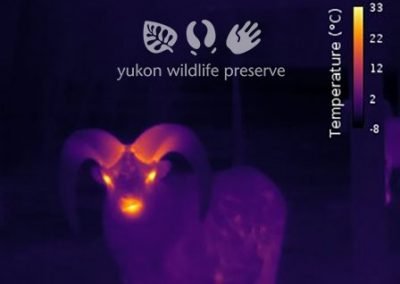
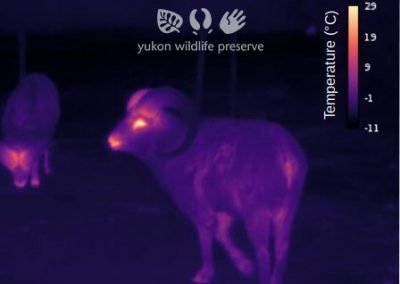
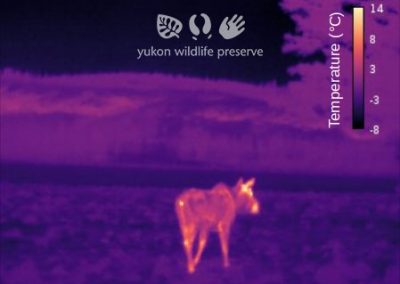
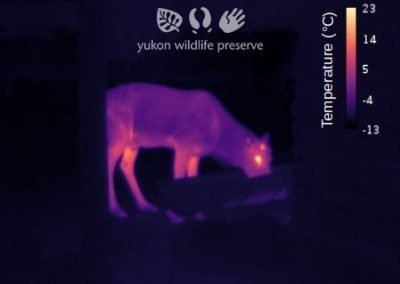
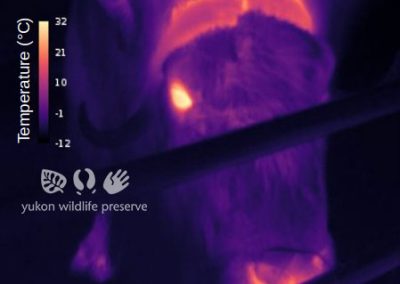

0 Comments